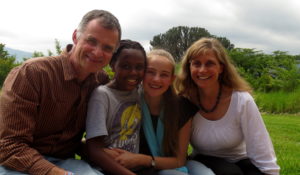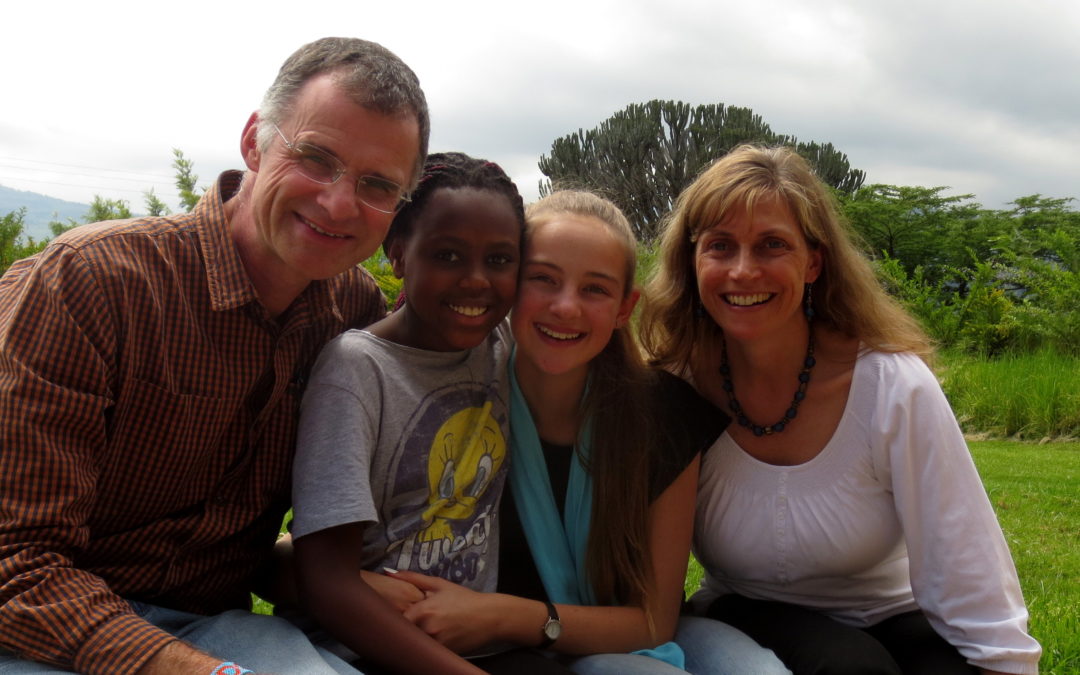Article by Dr. Peter Bird
AIC Kijabe Hospital, Kijabe 00220, Kiambu County, Kenya
Abstract: This is an personal reflection on the challenges of managing advanced breast cancer in a resource-poor setting, focussing on financial constraints, unavailability of treatment options, and the personal cost to patient and surgeon. © 2016 Elsevier Ltd. All rights reserved.

Picture: Dr Peter Bird, with his wife Sue and some of his family.
Muthonia is distraught and I am despondent. It has been a tough 12 months for her, and this was the last straw. She had been admitted for a mastectomy but I had to tell her it couldn’t be done. Her cancer was fixed to the chest wall and the lateral edge of the sternum. For 15 minutes I moved it this way and that e could I excise the breast and some chest wall and cover the defect with mesh and a myocutaneous flap? As aggressive as I am with locally advanced breast cancer surgery, I decided it would be too risky, and likely to leave tumour behind. To make matters worse, she had developed contralateral axillary involvement and a tumour in the tail of her other breast, so a bilateral mastectomy would be needed. Why had she waited so long after her original booking for surgery 4 months ago when it was operable? She told me between sobs. It was heart-breaking.
I first met Muthoni e a 38 year old mother of two young children e when she was in our hospital 10 months previously, giving birth to her second child. She’d noticed a mass in her breast months earlier but she had dismissed it as part of the breast changes of pregnancy. Antenatal care wasn’t done which may have helped with an earlier diagnosis. According to The Lancet Commission on Global Surgery published last year [1], Muthoni is among the 5 billion people on earth who can’t access timely surgical care, an astonishing statistic. She developed a locally advanced breast cancer (LABC), a grade 3 invasive ductal carcinoma, with ER/PR/HER2 all positive. Over 50% of breast cancers in our hospital [2], in Sub-Saharan Africa and other low income countries (LICs) present locally advanced. In 1894, William Halsted published his sentinel article on breast cancer surgery in the USA, and described the radical surgical technique named after him [3]. He described a series of patients over 50% of whom had LABCs at presentation. It’s appalling to realize that the majority of breast cancers in Africa are still presenting in the same way, 120 years behind the continents of North America, Europe and Australia
I referred Muthoni to an oncologist in Nairobi for neoadjuvant chemotherapy and a cheaper-than-usual regimen was administered. Over the next 5 months she completed 6 cycles and was referred back to me early this year. The response had been good, and the breast could now be excised. We enrolled Muthoni in our Watsi program, a US-based crowd funding platform that is literally a life-saver for our patients [4]. With Watsi’s help Muthoni could get her surgery for free. So why then did she delay 4 months and allow the cancer to regrow and spread to the other side?
Chemotherapy in Kenya costs over USD1000 in the private sector. It’s cheaper in government facilities, but there are very few that have oncology units, except the two major teaching and referral hospitals. But referring there is a gamble, completely hit or miss -will she get an early enough appointment? Will they have the drugs this month? So to get expedient and reliable treatment, I refer to private facilities that are relatively expensive but can get the job done. Patients needing money raise it through their family and local community, the harambee spirit that is a wonderful part of Kenyan culture. But in Muthoni’s case, it wasn’t enough. With other loans outstanding and in desperation, her husband secured another loan by falsifying details. Shortly after I saw Muthoni in January and arranged her surgery for the following week, her husband was arrested and jailed for fraud. She had to stay home and look after her young children on their meagre income until her husband could be freed from jail.
One quarter of all people in the world who have a surgical procedure will face financial catastrophe as a result of seeking care [1]. This amounts to over 80 million people, most of whom are poor already like Muthoni. The World Bank currently estimates the gross national income (GNI) per capita in Kenya at USD1290, placing Kenya into the low middle income country grouping for the first time [5]. For most Kenyans, this is still way above their annual incomes, as I suspect this figure is due to the small, but burgeoning middle class. Consider your annual gross income for a moment. It will probably be much higher than the GNI per capita of your country. Now, try and imagine coming up with your annual gross income in cash for your treatment. That’s what Muthoni and her husband had to do, and chemotherapy’s just a part of her optimal breast cancer treatment. Surgery will be USD400-600 (without Watsi help), then radiotherapy (RT) an additional USD1000 and finally USD700 for 5 years endocrine treatment with tamoxifen for the over 70% of Kenyan breast cancer patients who are hormone-receptor-positive [6]. Aromatase inhibitors would be 5e10 times more expensive. RT would be much cheaper at Kenyatta National Hospital, the only public RT centre in Kenya; however, its two radiotherapy machines e one an old cobalt unit, the other a more modern linear accelerator e are completely swamped by Kenya’s population of over 47 million, with inordinately long waiting lists and frequent machine breakdowns. In 2013, the International Atomic Energy Agency estimated Kenya needed 38 more units [7]. By comparison, Australia, with half the population of Kenya has 76 radiotherapy units [8]. One of the 7 private RT centres in Nairobi are often my patients’ only hope for this important component of breast cancer treatment.
I follow closely the exciting developments in targeted biological cancer therapies, with promises of more and more cancer cures. These are very important, but who’s concerned about the cost? Mostly just those of us working in low and middle income countries (LMICs) who must do so, because universal health coverage doesn’t exist here and our patients are poor. It’s ludicrous to think Muthoni could afford even one cycle of monoclonal antibody treatment, now recommended for HER2-positive breast cancer in international guidelines [9]. A 12-month treatment course of trastuzumab e somehow on the 19th WHO Essential Medicines list [10] e costs over USD25,000. This time, multiply your gross annual income 25 times and come up with that amount in cash.
Cancer care guidelines are written in high income countries (HICs) but followed all over the world; however, until recently they were not written with any economic considerations. The Breast Health Global Initiative (BHGI) is trying to rectify this, with the development of resource-stratified guidelines [11,12]. These are very welcome. BHGI is also working with the National Comprehensive Cancer Network (NCCN) to do the same with other cancers, using existing NCCN Guidelines [9]. In Kenya, I am working with the Ministry of Health and our national breast cancer experts, trying to adapt these to our local situation. The G4Alliance [13], birthed out of the Lancet Commission on Global Surgery, is also advocating loudly for the global health community to step up and help LMICs improve the provision of timely and appropriate surgical and anaesthetic care for billions of people without it.
Muthoni couldn’t really afford the chemotherapy. Tell a patient in Kenya they need to raise USD1000 to give them a better chance of cure, no matter how small the chance, and they’ll impoverish their families by forgoing their children’s school fees and selling their only cow. Or worse, take out yet another loan using false documents. What if the treatment increases the chance of cure by a lot more than a few percentage points, as is often the case with a LABC? I’ll push for this in most cases, but if I know my patient is very poor, I will suggest the cheapest options like surgery and endocrine therapy with a lower chance of cure, and not mention the expensive ones. But maybe they can raise the money somehow. Is this my job as a surgeon sitting in a crowded rural Kenyan surgical clinic, to order tests and treatments based on a “guestimation” of what my patients can afford? It certainly isn’t when I’m back working in my HIC, Australia. But here in rural Kenya, it’s my first consideration as I plan my patients’ treatment. I don’t want to be the one destroying a family financially by suggesting relatively expensive therapies that might not work. But neither do I want to lessen their chance of cure. My advice can devastate a family for a generation. I must be very careful.
The disparity in health care between HICs and the rest of the world is obscene and only widening [14]. In 2016, American surgeons hardly see what Halsted saw in 1894 because the USA is now a high income country. I fear that across the countries of the world, equality in breast cancer presentation and treatment will only happen when there is economic parity. Perhaps this is driving my despondency as I consider Muthoni’s plight, because the world seems to be moving away from this. All we have to achieve e like the declared desire of the beauty pageant finalist e is an end to world poverty. Muthoni’s wailing and sobbing moved me unusually. Kenyans are stoic, but once death comes, they grieve noisily. This was like someone had died and I wondered if she’d lost all hope. I discharged her on tamoxifen hoping for an endocrine-driven response, as repeating the chemotherapy was not possible. Maybe I can get the tumour operable again with this cheap therapy. She left the hospital with as much hope as I could give her. After 16 years of doing this in Kijabe, I’m tired. I got it wrong with Muthoni, and that’s disheartening. But I have many survivors that I’ve got right, enough to keep fighting on and not lose hope. But surgeons in this part of the world need help. Who is going to support us so we can continue to help the Muthonies we see every day?
Conflict of interest statement: I declare no conflict of interest.


Trackbacks/Pingbacks